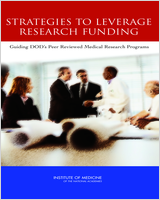NCBI Bookshelf. A service of the National Library of Medicine, National Institutes of Health.
This report addresses the question of whether it is possible and desirable to augment the appropriated dollars for CDMRP with funding from other sources. The answer to the of whether it is possible rests on an analysis of nonfederal sources of funding and mechanisms that may be available to access them, as well as potential impediments to that process. The answer to whether it is desirable rests on an analysis of how these other sources and funding mechanisms might affect the goals and effectiveness of CDMRP. Desirability also depends on how “augmentation” is defined. Augmentation of funding that increases public health, for example, by creating a critical mass of knowledge or skills, or by joining complementary resources that are needed to solve a problem, or by enabling results that would not otherwise be possible, is more desirable than augmentation that only serves to extend program funds, especially if the additional funds are not newly applied to biomedical research and are simply shifted from other biomedical research uses.
Contents
- THE NATIONAL ACADEMIES
- COMMITTEE ON ALTERNATIVE FUNDING STRATGIES FOR DOD'S PEER REVIEWED MEDICAL RESEARCH PROGRAMS
- Reviewers
- Preface
- Abbreviations and Acronyms
- Executive Summary
- 1. Introduction
- 2. Sources of Funding for Biomedical Research
- 3. Examples of Leveraging Nonfederal Dollars for Research
- 4. Assessment of Alternative Sources and Mechanisms of Nonfederal Support
- 5. Findings and Recommendations
- A Selected Federal Programs with Nonfederal Funding Participation
- B Biographical Sketches of Committee Members
- C Workshop Agenda
- D Leveraging Public Investments with Private Sector Partnerships: A Review of the Economics Literature
This study was supported by Contract No. W81XWH-04-C-0077 between the National Academy of Sciences and the U.S. Department of Defense. Any opinions, findings, conclusions, or recommendations expressed in this publication are those of the author(s) and do not necessarily reflect the view of the organizations or agencies that provided support for this project.
NOTICE: The project that is the subject of this report was approved by the Governing Board of the National Research Council, whose members are drawn from the councils of the National Academy of Sciences, the National Academy of Engineering, and the Institute of Medicine. The members of the committee responsible for the report were chosen for their special competences and with regard for appropriate balance.
- NLM CatalogRelated NLM Catalog Entries
- Review Evaluation of the Congressionally Directed Medical Research Programs Review Process[ 2016]Review Evaluation of the Congressionally Directed Medical Research Programs Review ProcessNational Academies of Sciences, Engineering, and Medicine, Health and Medicine Division, Board on the Health of Select Populations, Committee on the Evaluation of Research Management by DoD Congressionally Directed Medical Research Programs (CDMRP). 2016 Dec 19
- Financial anatomy of biomedical research.[JAMA. 2005]Financial anatomy of biomedical research.Moses H 3rd, Dorsey ER, Matheson DH, Thier SO. JAMA. 2005 Sep 21; 294(11):1333-42.
- Procedures and methods of benefit assessments for medicines in Germany.[Eur J Health Econ. 2008]Procedures and methods of benefit assessments for medicines in Germany.Bekkering GE, Kleijnen J. Eur J Health Econ. 2008 Nov; 9 Suppl 1:5-29.
- American Society of Clinical Oncology policy statement: oversight of clinical research.[J Clin Oncol. 2003]American Society of Clinical Oncology policy statement: oversight of clinical research.American Society of Clinical Oncology. J Clin Oncol. 2003 Jun 15; 21(12):2377-86. Epub 2003 Apr 29.
- Review The researcher development program: how to extend the involvement of Australian general practitioners in research?[Rural Remote Health. 2007]Review The researcher development program: how to extend the involvement of Australian general practitioners in research?Birden HH. Rural Remote Health. 2007 Jul-Sep; 7(3):776. Epub 2007 Aug 14.
- Strategies to Leverage Research FundingStrategies to Leverage Research Funding
Your browsing activity is empty.
Activity recording is turned off.
See more...
